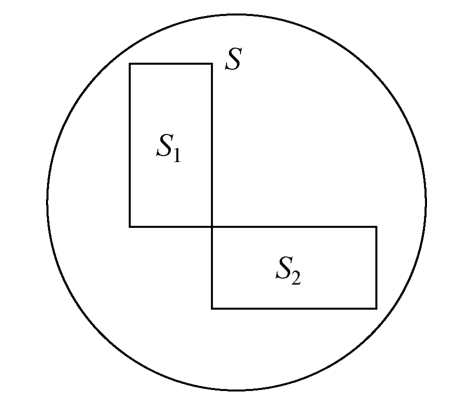




Linear space [4] ,especially vector space,is the basis for a thorough understanding of linear block codes.Linear space is the cornerstone of linear algebra.We have learned the concepts of linear space,linear independence,basis vectors and dimension in linear algebra.However,scalar and vector components are usually taken from real number fields in linear algebra.In order to combine linear space and coding better,this section extends these concepts to general number fields,especially GF( p )or GF( p m ).
Definition 1.3.1(Linear Space) Let F be a field.A linear space S based on F consists of an abelian addition group V and a left scalar multiplication of an element of F with an element of V ,such that for ∀ a , b ∈ F and ∀ α , β ∈ V ,the following properties are satisfied.
P 1 : a α ∈ V .
P 2 : a ( b α )∈ V .
P 3 :( a + b ) α =( a α )+( b α ).
P 4 : a ( α + β )=( a α )+( a β ).
P 5 :1 α = α .
With the definition,it should be noted firstly that the scalar left multiplication between the elements in F and the elements in V is not a binary operation within a set,but should be understood as a mapping from F × V to V .Secondly,in a general sense,the elements in V can be polynomials,matrices,vectors or even functions,but within the scope of this book,we mainly discuss vector space,so the elements in V are called vectors,and the elements in F are called scalars.When the components of the vector in V are also taken from F ,it is called the vector space based on the field F .Finally,both the 0 vector in V and the 0 scalar in F are denoted by 0.
Example 1.3.1
(1)The polynomial ring F [ x ] based on a field F is a linear space.
(2)The whole of all real variable functions{ f ( x )}with the definition domain(0,1)is a linear space.
(3)The whole of all real number matrix with the dimensions of m × n is a linear space.
Definition 1.3.2(Linear Combination) Let α 1 , α 2 , … , α m be a number of m vectors and k 1 , k 2 ,…, k m be a number of m scalars. k 1 α 1 + k 2 α 2 +…+ k m α m is called the linear combination of α 1 , α 2 ,…, α m .
Definition 1.3.3 A number of m vectors α 1 , α 2 ,…, α m are linear dependent if there are a group of scalars k 1 , k 2 ,…, k m which are not all zeros,such that k 1 α 1 + k 2 α 2 +…+ k m α m =0.Otherwise,they are linear independent .
Definition 1.3.4(Dimension) The largest number of independent elements in a linear space S is called the dimension of S .
Definition 1.3.5(Basis) Let S be a n -dimensional linear space.If ε 1 , ε 2 ,…, ε n are a number of n independent vectors,then{ ε 1 , ε 2 ,…, ε n }is called a basis of S .
Theorem 1.3.1 If{ ε 1 , ε 2 ,…, ε n }is a basis of S ,then any vector α could be uniquely represented by the linear combination of ε 1 , ε 2 ,…, ε n ,such as α = a 1 ε 1 + a 2 ε 2 +…+ a n ε n ,and the coefficient( a 1 , a 2 ,…, a n )is called the coordinates of α with respect to{ ε 1 , ε 2 ,…, ε n }.
Definition 1.3.6(Subspace) For any vector space,a subspace is a subset that is itself a vector space under the inherited operations.
Definition 1.3.7(Span) The span(or linear closure)of a nonempty subset S' of a vector space S is the set of all linear combinations of vectors from S' ,i.e.,
[ S' ]={ a 1 s 1 + a 2 s 2 +…+ a n s n , a 1 , a 2 ,…, a n ∈ F and s 1 , s 2 ,…, s n ∈ S '}
Definition 1.3.8(Inner Product) The inner product(or dot product)of two vectors u =( u 0 , u 1 ,…, u n -1 )and v =( v 0 , v 1 ,…, v n -1 )is the number
u · v = u 0 v 0 + u 1 v 1 +…+ u n -1 v n -1
It should be emphasized that the result of inner product is a number.The inner product has the following properties.
P 1 :Symmetry u · v = v · u
P 2 :Distribution u ·( v + w )= u · v + u · w
P 3 :Association ( a u ) · v = a ( u · v )
P 4 :Positive definiteness u · u ≥0
Especially,if the inner product of u and v is 0,then the two vectors are orthogonal.
Definition 1.3.9(Null Space) Let S 1 be a subspace of a n -dimensional vector space S .All vectors orthogonal to every vector in S 1 form another subspace S 2 of S .It is called S 1 and S 2 are null space to each other.
Figure 1.3.1 illustrates the relations of two null spaces.From the viewpoint of equations,the null space of S 1 consists of all solutions to S 1 x =0,so it is also called solution space.

Figure 1.3.1 S 1 and S 2 are null space for each other
Theorem 1.3.2 Let S 1 be a subspace of a n -dimensional vector space S and S 2 be the null space of S 1 .If the dimension of S 1 equals k ,then the dimension of S 2 equals n - k .